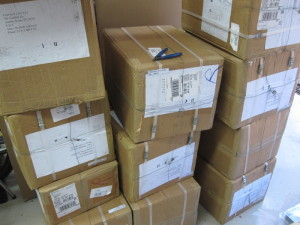Hey Everybody!
Just a quickie update this New Years Eve!
Our contract manufacturer shipped the first 2000 Pixys, and here they are, waiting for the lens attachment, the final firmware upload (when the final firmware is ready!) and packaging. More are on their way!


As far as software, we’ve been focusing on readying the image processing algorithms. One thing that’s worth noting is that we’ve upped the performance of the color blob algorithm by reducing its latency (the amount of time it takes for Pixy to sense something.)
The latency was pretty amazing at about 1.5 frames or 30ms, but now it’s as little as 0.5 frames or 10ms. This means among other things, that tracking objects is really dang fast.
Clarifying note— the update rate of Pixy is 50 frames per second (50 Hz), which is also the update rate of the image sensor. Latency can be independent of the update rate, though. So for example, latency can be several frames without affecting the update rate. USB webcams typically have a latency of about 100 ms for video frames. (Update rates for webcams are typically 30 Hz or 33 ms.) Add image processing and the latency is even suckier! (that’s for webcams— Pixy’s latency, which includes image processing, can be as little as 10 ms! dang!)
OK, enough of this latency and update crap! Let’s see a demo!
https://www.youtube.com/watch?v=ja5geAAlOC0
- The USB cable is for power only— no batteries needed! But you could use batteries if you wanted to, by plugging them into the external power connector. (Pixy has a built-in regulator, so you can plug in a battery, 6.0V to 12V.)
- The mechanism in the demo is basically the one we’re shipping, but with a few tweaks to improve it that extra little bit.
- Pan/tilt mechanism is still available for pre-order!
- We are using Pixy’s built-in servo ports. The tracking algorithm is running on Pixy. We’ll provide an Arduino sketch where the tracking algorithm and servo control happens through the Arduino!
- All of this is mostly for fun— although this may have important applications in the field of colorful object theft prevention. (Sorry– that was the best I could come up with…..)
That’s all for now! More focus on image processing firmware over the next couple weeks.
Happy New Year! Looking forward to seeing Pixy on your robot in 2014!



